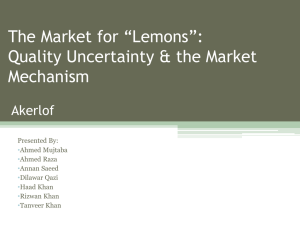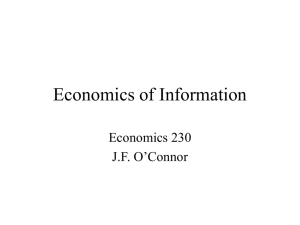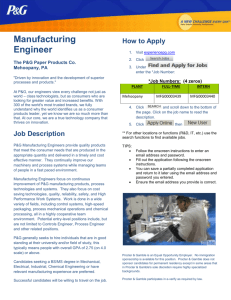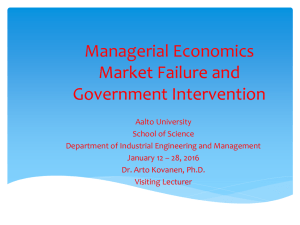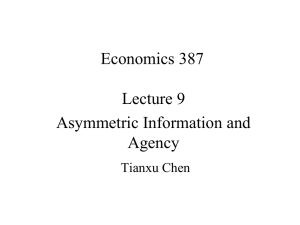Lecture Slides 12
advertisement
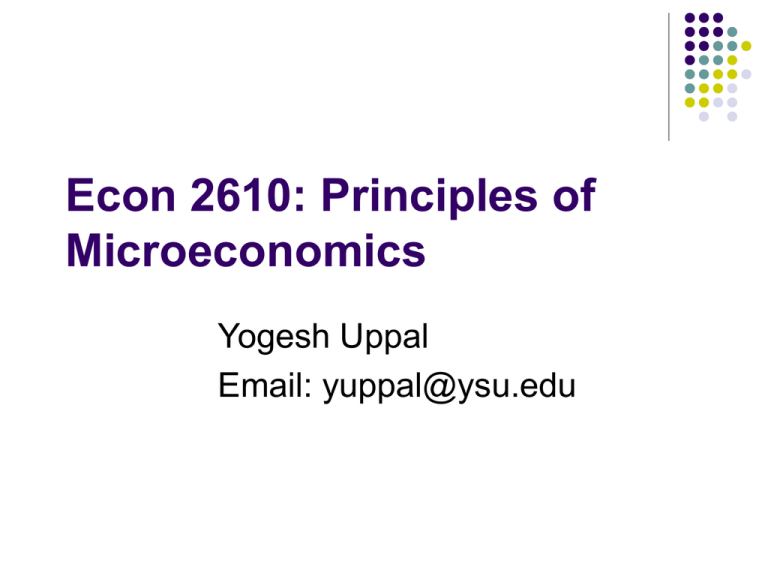
Econ 2610: Principles of Microeconomics Yogesh Uppal Email: yuppal@ysu.edu Chapter 12 The Economics of Information Information and the Invisible Hand All parties have all relevant information Without free information, market results are not efficient Bargaining for a bowl in Kashmir Parties must decide how much information to gather Information gathering strategies differ The Optimal Amount of Information More information is better than less Gathering information has a cost Marginal benefit starts high, then falls rapidly Marginal cost starts low, then increases Low-Hanging Fruit Principle Optimal amount of information is I* where MC = MB Optimal MC $/unit I* Units of information MB Free Rider Problem A free-rider problem exists when nonpayers cannot be excluded from consuming a good Interferes with incentives Market quantity is below social optimum Stores bear the cost of training sales reps on merchandise Shoppers use sales reps as information source Then some shoppers buy elsewhere Store is unable to capture some of the value it delivered to the shopper: a free-rider problem Gamble Inherent in Search Additional search has costs that are certain Benefits are uncertain benefits Additional search has elements of a gamble A gamble has a number of possible outcomes Each outcome has a probability that it will occur Gamble Inherent in Search The expected value of a gamble is the sum of (the possible outcomes times their respective probability) A fair gamble has an expected value of zero A better-than-fair gamble has a positive expected value Risk Preferences A risk-neutral person would accept any gamble that is fair or better-than-fair A risk-averse person would refuse any fair gamble Asymmetric Information Asymmetric information occurs when either the buyer or seller Is better informed about the goods in the market Mutually beneficial trades may not occur A seller might know that a murder was committed in a house offered for sale Buyer does not know Buyer Seller Private Sale of a Used Car Jane's Miata is in excellent condition Jane's reservation price is $10,000 Blue Book value is $8,000 Tom wants to buy a Miata His reservation price is $13,000 for one in excellent condition and $9,000 for one in average condition Determining the condition of Jane's car has a cost and the results are uncertain Tom cannot verify that Jane's Miata is superior The Lemons Model People who have below average cars (lemons), are more likely to want to sell them Good quality cars are withdrawn from the market Buyers know that below average cars are likely to be on the market and lower their reservation prices Average quality decreases further and reservation prices decrease again The lemons model says that asymmetric information tends to reduce the average quality of goods for sale Your Aunt's Car Your aunt offers you her 4-year old Accord The asking price of $10,000 is the blue book value You believe the car is in good condition Blue book value is the equilibrium price for below average cars You should buy the car for $10,000 It is in better condition than the average Accord of the same vintage and mileage Naïve Buyer Two kinds of cars: good cars and lemons Owners know what kind they have Buyers can't determine a car's quality Buyers are risk neutral What would the buyer offer for a used car? Expected value of a car is (0.90) ($10,000) + (0.10) ($6,000) = $9,600 The buyer gets a lemon Probability Value Good Cars Lemons 90% 10% $10,000 $6,000 Credibility Problem Parties gain if they find a way to communicate information truthfully If Jane can convince Tom her Miata is in excellent condition, Tom will buy Statements are not credible Jane offers Tom a six-month warranty on all car defects at the time of purchase A warranty for a lemon would cost more than the economic surplus gained Only sellers of good quality cars would offer the warranty Adverse Selection Adverse selection occurs because insurance tends to be purchased more by those who are most costly for companies to insure Insurance is most valuable to those with many claims Adverse selection increases insurance premiums Reduces attractiveness of insurance to low-risk customers "Best" insurance risk customers opt out Rates increase Repeat Moral Hazard Moral hazard is the tendency of people to expend less effort protecting insured goods People take more risk with insured goods or activities Deductibles give policy holders an incentive to be more cautious Suppose a car owner has a $1,000 deductible policy The owner pays the first $1,000 of each claim Strong incentive to avoid accidents Claims less than $1,000 are not reported Insurance premiums go down
